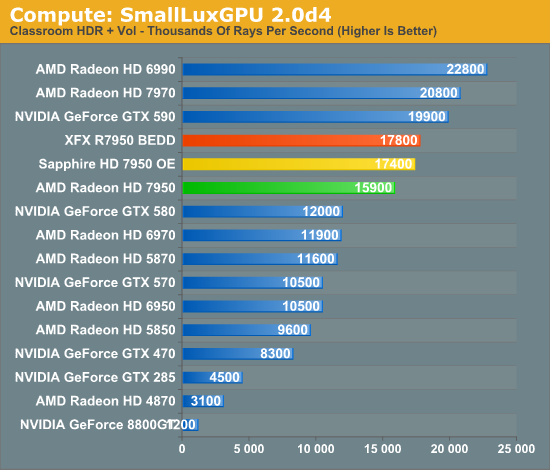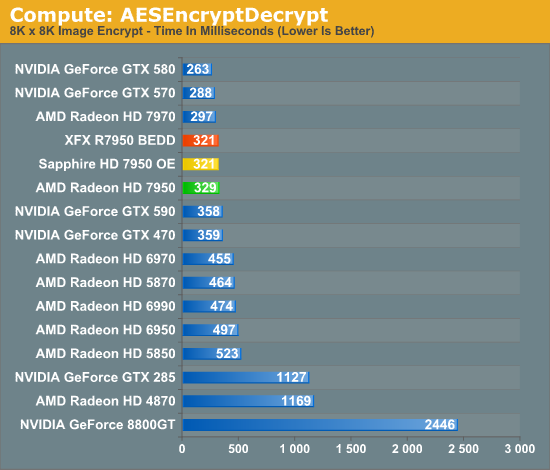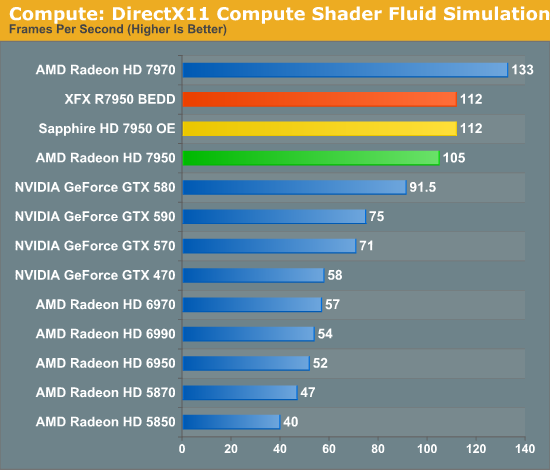AMD Radeon HD 7950 Review Feat. Sapphire & XFX: Sewing Up The High-End Market
by Ryan Smith on January 31, 2012 9:02 AM ESTCompute Performance
Moving on from our look at gaming performance, we have our customary look at compute performance. Since compute performance is by definition shader bound, the 7950 is at a bit of a disadvantage here compared to gaming performance. Whereas ROP performance scales with the core clock, shader performance is hit by both the reduction in the core clock and the disabled CU array.
Our first compute benchmark comes from Civilization V, which uses DirectCompute to decompress textures on the fly. Civ V includes a sub-benchmark that exclusively tests the speed of their texture decompression algorithm by repeatedly decompressing the textures required for one of the game’s leader scenes. Note that this is a DX11 DirectCompute benchmark.

AMD’s greatly improved compute performance continues to shine here, though in the case of Civilization V it’s largely consumed by just closing the previously large gap between the GTX 500 series and the Radeon HD 6000 series. As a result the 7950 falls ever so short of the GTX 580, while the factory overclocked Sapphire and XFX cards give the 7950 enough of a push to come within 5% of the 7970.
Our next benchmark is SmallLuxGPU, the GPU ray tracing branch of the open source LuxRender renderer. We’re now using a development build from the version 2.0 branch, and we’ve moved on to a more complex scene that hopefully will provide a greater challenge to our GPUs.

Under SmallLuxGPU the 7970 enjoyed a large lead over the GTX 580, and this continues with the 7950. Even though the 7950 is well behind the 7970—to the tune of 24%—it’s still 33% ahead of the GTX 580 and the lead only grows from there. Meanwhile the XFX and Sapphire cards can catch up to the 7970 somewhat, but as this is truly a shader-bound test, you can’t make up for the lack of shaders units on the 7950.
For our next benchmark we’re looking at AESEncryptDecrypt, an OpenCL AES encryption routine that AES encrypts/decrypts an 8K x 8K pixel square image file. The results of this benchmark are the average time to encrypt the image over a number of iterations of the AES cypher.

In spite of being a compute benchmark, AESEncryptDecrypt is not particularly sensitive to GPU performance, showcasing the impact that setup times can have. The 7950 trails the 7970 by 10%, and overclocking doesn’t change this much. Unfortunately for AMD NVIDIA is still the leader here, showing that AMD’s compute performance still has room to grow.
Finally, our last benchmark is once again looking at compute shader performance, this time through the Fluid simulation sample in the DirectX SDK. This program simulates the motion and interactions of a 16k particle fluid using a compute shader, with a choice of several different algorithms. In this case we’re using an (O)n^2 nearest neighbor method that is optimized by using shared memory to cache data.

With the compute shader fluid simulation we once again shift back into a compute task that’s much more shader-bound. The 7950 only reaches 80% of the performance of the 7970, once more proving the real impact of losing a CU array. This is still enough to handily surpass the GTX 580 however, with the 7950 taking a 15% lead.










259 Comments
View All Comments
nissangtr786 - Wednesday, February 1, 2012 - link
At the end of the day the 7970 and 7950 are great cards. They are like going from a 65nm pentium 4 to a 45nm core 2 duo in terms of performance per watt. Yes AMD may have not cranked the power consumption like amd do but performance per watt or gflops per watt it is basically double or even better then the last generation 40nm cards.Imagine 10000 40nm gtx 580 running in the world or 10000 7950 running in the world. Saving 160w more each person with similar person. 160w is a lot of power enough to run nearly an m17x r3 with 6970m.
160w multiplied by 10000 people = 1600000 watt difference for same performance of a gtx 580 and 7950. Thats 1.6m watts in simple terms more to game. If process and architecture changes of cpus and graphics cards didn't happen we would still have pentium 4's running at 3.8ghz with 6800 utras taking nearly as much power to run as an i7 3960x and 7970. Also idle watts usage go down every die shrink.
JNo - Thursday, February 2, 2012 - link
I'm surprised you didn't give the Sapphire a Gold Editor's choice award.It is pretty much awesome in every respect and I don't see any drawbacks.
No I don't work for Sapphire but this is the card I'd buy tomorrow (if I really needed it/had more money!)
Finally - Thursday, February 2, 2012 - link
Sapphire did do their homework. I find it astonishing that they were the only ones to consider undervolting, while also overclocking their product. Hats off!chizow - Thursday, February 2, 2012 - link
No, Tahiti is competing with the expectations of a new generation of hardware, expectations they clearly failed to meet. You don't ask for flagship prices when all you bring to the table is refresh performance of 14 month old last-gen parts. If you don't think so, but hey np, I have a copy of Madden 2010 you can buy for $60.How are my expectations too high? More like your expectations are too low if you were impressed with Tahiti. 15-25% faster than the last-gen flagship? Is that a joke? Once again, next-gen expectations commanding flagship prices should be AT LEAST 50% before anyone considers buying. Y'know, the same speed bump that "clusterfk" Fermi was over the last-gen parts...... Once again low expectations of AMD fans just used to being mediocre I suppose....
And to disprove your nonsense again with historical fact, Nvidia did have the fastest card in 2010 with GTX 480, but instead of raising the prices, they kept it the same with the GTX 580. They've done this in the past as well with the GTX 280 > GTX 285. They don't raise prices on refreshes, they also don't raise prices on flagships on new generations because they learned their lesson with GTX 280 after the original pricing fiasco.
chizow - Thursday, February 2, 2012 - link
Wrong again.The rebates were funded by Nvidia for price protected "exclusive" partners in NA and EU markets. At the time, that was EVGA, BFG and XFX.
The partners only sent out the rebate because they received the bulk of payment after shipping to retailers, but only with Nvidia's green light. Nvidia also directly funded/reimbursed or promised more inventory using the credited difference for any existing stock in the channel when they officially dropped the price of the GTX 280 from $650 to $500 and the GTX 260 from $450 to $350. Prices on the top two cards have stayed virtually the same since.
But yes, AMD is setting themselves up for a similar fall. If they priced the 7970 the same as the previous flagships, $500. No one would care that much. If they priced the 7950 the same as their previous 2nd tier, $380-400. No one would care that much.
But they got greedy. For what? 15-25% improvement on a new architecture, full node, and 14 months? History is due to repeat itself, and not in AMD's favor. At least in Nvidia's case, the GTX 280 actually warranted its pricetag relative to last-gen parts. You can't even say that about the 7970.
chizow - Thursday, February 2, 2012 - link
Well if a $300 card is priced where it should be and performs the same as AMD's $450 card something will certainly have to budge.Unless Nvidia decides to just refresh their old parts on 28nm and prices everything the same for a 5-10% increase in performance.
In that case, we can all just not buy video cards this generation because nothing will be worth buying and we can stop pretending these new cards are some awesome new innovation.
chizow - Thursday, February 2, 2012 - link
They're still $500 because demand is still strong, its close to EOL, and people still find value in Nvidia parts over AMD.They'll drop the prices to sell off the last few in the channel when they replace the part with something better, but in the meantime, AMD hasn't given any reason for them to slash the prices due to their greedy pricing on the 7950.
Again, this is a departure from past launches where AMD did price their parts sensibly and forced Nvidia to lower prices on its flagship cards (GTX 285 etc).
4 of 11 out of stock is good? After 4 days on the market? I don't think so. I think the market has spoken given every other major launch in the last few years on a high-end SKU like this has resulted in OOS for about a month.
Demand for this part is soft, and at its price/performance that's no surprise and really shouldn't be.
chizow - Thursday, February 2, 2012 - link
Really? So being the highest-end SKU that AMD produced and within 10-15% of the fastest single-GPU on the planet, it wasn't a high-end card? And I guess AMD didn't have any high-end cards that generation?And "pricing ALWAYS based on performance relative to the competition". So the RV770 coming within 10-15% of the GTX 280 which already launched for $650 and was selling briskly because it deserved that pricing relative to last-gen (9800GX2, 8800GTX) and AMD pricing this part for $299 made sense based on performance relative to the competition? Really?
You're wrong. Stop posting LMAO. RV770 was a price mistake on AMD's part, a mistake they've been trying to correct ever since. Now Nvidia has a chance to return the favor because the 7970/7950 are going to be in a similar position due to the fact they're mispriced based on last-gen metrics.
chizow - Thursday, February 2, 2012 - link
Newsflash: if you want the newer part, you actually expect better performance for the same price compared to parts that have been out for over a year.Welcome to my used car lot where I sell old cars for brand new prices.
chizow - Thursday, February 2, 2012 - link
And that's exactly what's wrong with their pricing, an error that will be obvious once its competing against the products its supposed to be competing with.By your same flawed logic, graphics cards would be thousands of dollars as every incremental increase would incur an increase in price without limits.